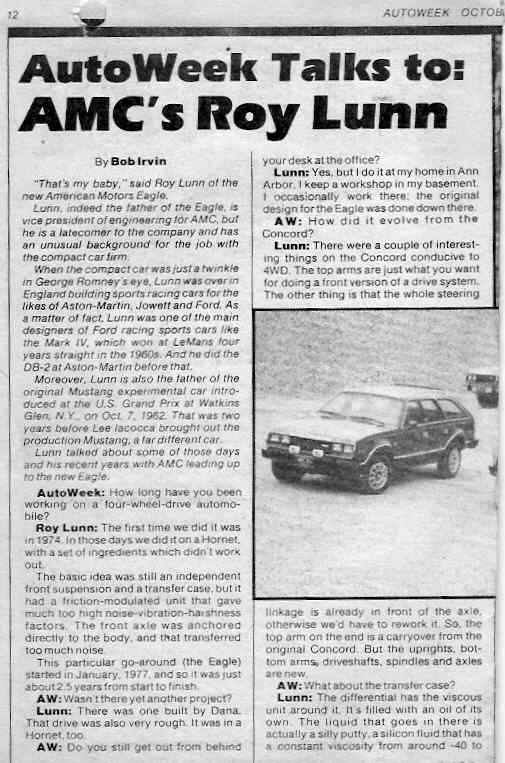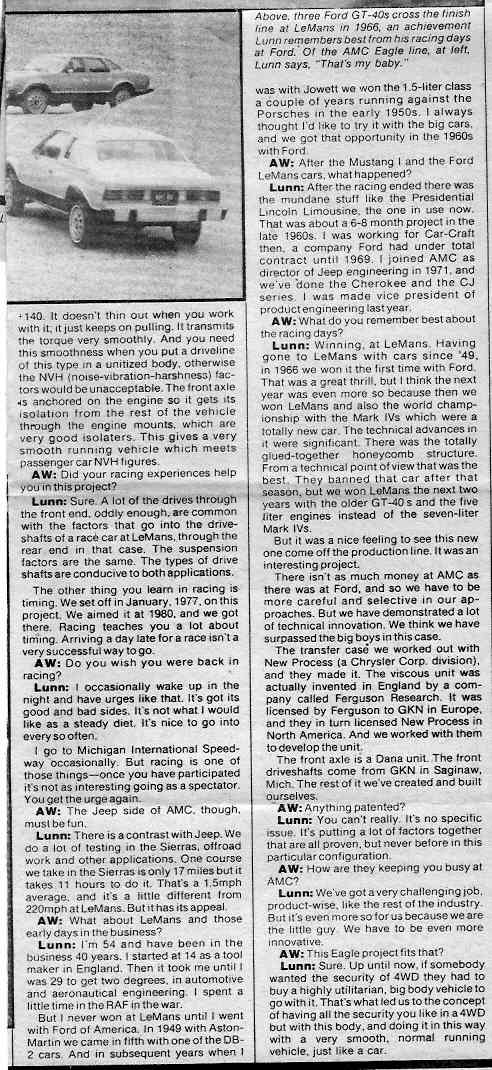Difference between revisions of "Roy C. Lunn"
| Line 10: | Line 10: | ||
He retired from AMC in 1985 and was immediately called back to become vice-president of engineering for the AM General Corporation (an AMC subsidiary), which was going into production of the HUMMER military vehicle. AMC was facing acceptance problems by the Army and asked Mr. Lunn to correct these problems. After overseeing the corrective actions Mr. Lunn finally retired to his home in Florida in 1987 and then to Italy in 2004, after having spent forty-one years in the design, development and production of automotive vehicles. | He retired from AMC in 1985 and was immediately called back to become vice-president of engineering for the AM General Corporation (an AMC subsidiary), which was going into production of the HUMMER military vehicle. AMC was facing acceptance problems by the Army and asked Mr. Lunn to correct these problems. After overseeing the corrective actions Mr. Lunn finally retired to his home in Florida in 1987 and then to Italy in 2004, after having spent forty-one years in the design, development and production of automotive vehicles. | ||
| + | |||
| + | |||
| + | === October, 1980 Auto Week Interview with Roy Lunn === | ||
| + | |||
| + | |||
| + | [[Image:aw01.jpg]] | ||
| + | |||
| + | |||
| + | [[Image:aw02.jpg]] | ||
| + | |||
| + | |||
| + | [[Image:aw03.jpg]] | ||
Revision as of 19:00, 26 November 2005
Information contained in this biography was recieved from Mr. Lunn in the fall of 2004 and is used with his permission.
Roy C. Lunn was born in 1925 and was educated in England where he graduated in mechanical and aeronautical engineering. He served two years in the RAF as a UT pilot. After the war, in 1946, he entered the auto industry as a designer of AC cars and then went to Aston Maritin in 1947 where he became assistant chief designer and was responsible for the DB2 program. He joined Jewett Cars in 1949 as chief designer and was responsible for a range of vehicles which included the first plastic bodied car. He drove in competition and was co-driver to Marcel Becquart, driving to victory in the 1952 RAC International Rally. In 1953 he went to Ford of England and was assigned the task of starting a new research facility in Birmingham. This center generated the first prototype of what became the 105 E. Anglia.
Lunn was then transferred to Ford of Dagenham as the car product planning manager to follow the 105-E into production. He immigrated to the U.S. in 1958 to join Ford USA where he became the manager of the Ford Advanced Vehicle Center, working on a whole range of world-wide projects including: Mustang I; a super highway 170,000 pound GCW truck; and Ford's first front wheel drive car, the Cardinal, which became the Taunus 15-M in Germany.
In 1962 he became a U.S. citizen. Also, during the same year, he and part of his department were put on special assignment to design and develop a GT racing car to beat Ferrari and win the world GT championship. This became the GT-40, followed by the MK II and MK IV that won LeMans four times in succession between 1966 and 1969 and two world championships.
In 1971 Lunn joined American Motors as director of engineering for Jeep which had recently been acquired by AMC. He went on to become vice-president of engineering for AMC with his notable accomplishments being the Jeep XJ Cherokee which was the first of the modern range of SUV vehicles and the Eagle, which was America's first 4WD car. He was also active in the Society of Automotive Engineers becoming their chairman in 1983 and was elected a Fellow of the Society in 1985. He completed his career at AMC by forming and becoming president of Renault Jeep Sport to centralize all AMC and Renault racing activities in the U.S., including the design and production of a low-cost racing car for SCCA, of which more than 500 models have been built. In 1984 he headed the first American entry to drive in the Paris-Dakar rally.
He retired from AMC in 1985 and was immediately called back to become vice-president of engineering for the AM General Corporation (an AMC subsidiary), which was going into production of the HUMMER military vehicle. AMC was facing acceptance problems by the Army and asked Mr. Lunn to correct these problems. After overseeing the corrective actions Mr. Lunn finally retired to his home in Florida in 1987 and then to Italy in 2004, after having spent forty-one years in the design, development and production of automotive vehicles.


